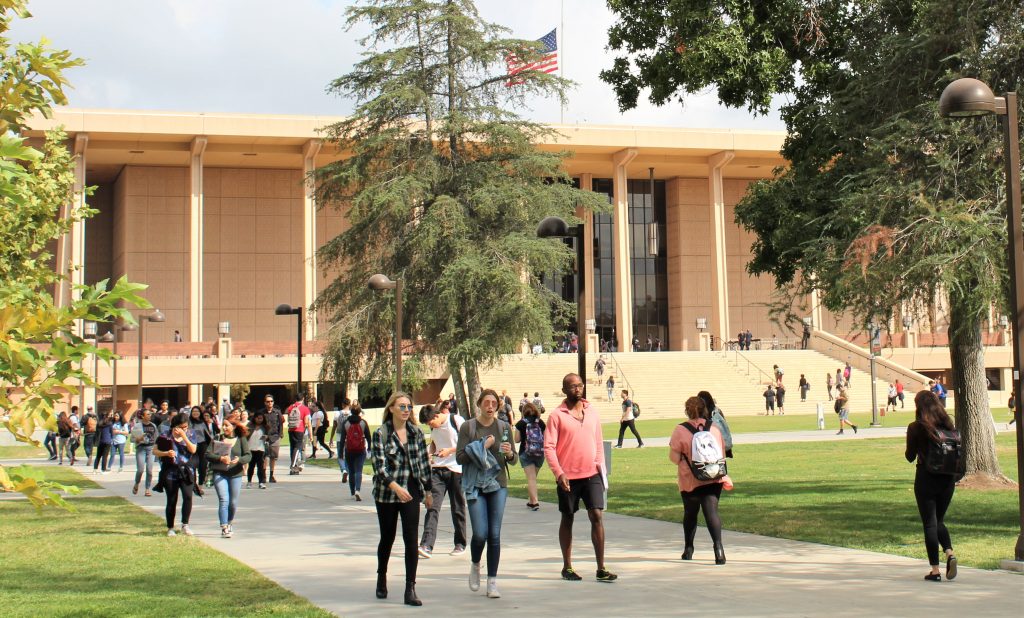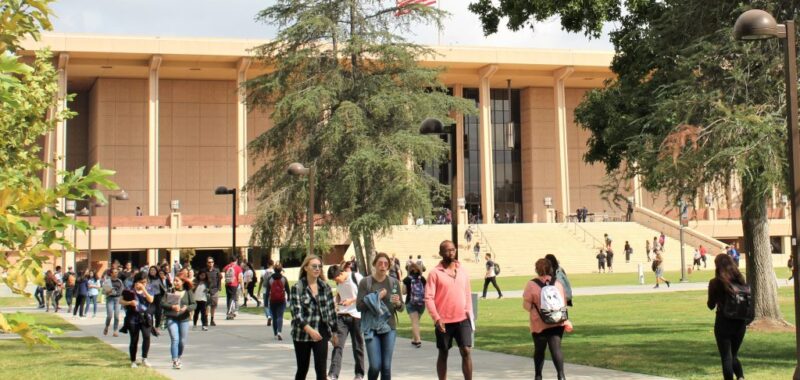
Cal State Northridge is one of 23 CSU System institutions.
Larry Gordon/EdSource
As the end of a decade-long push to graduate more students nears, California State University made slight progress in 2024 on increasing the four-year graduation rate for freshmen but saw six-year freshmen rates stall and four-year transfer rates drop, new statistics show.
Those numbers show the difficulties the university system faces in its final efforts to improve its graduation rates, even after significant overall improvement toward ambitious goals over the previous nine years.
The data were presented Tuesday at a two-day symposium on graduation goals ahead of spring 2025, when the CSU system’s much-scrutinized Graduation Initiative 2025 effort is supposed to end. CSU officials urged colleagues to learn more about why many students are dropping out or taking so long to finish.
Across the CSU system, freshmen six-year graduation rates have plateaued around 62%, the same as in 2023 and eight percentage points below the system’s graduation goal for 2025. Freshmen four-year graduation rates ticked up to 36% in 2024, a one-point gain from the previous year. But they fell shy of the system goal to hit 40% by 2025.
Transfer students’ performance was a mixed bag. Cal State is just one percentage point from reaching its goal of a 45% two-year graduation rate for transfers, a decent increase from 41% in 2023. But among transfer students who entered CSU in 2020, four-year graduation rates dropped from 79% in 2023 to 75% this year, putting them 10 points below the Graduation Initiative 2025 target.
The CSU also tracks graduation rates for its 23 campuses, all of which have been assigned varying goals. But the university system has not published campus graduation rates for 2024 to a dashboard available online and those were not included in the public report Tuesday.
Though the system’s current graduation rates compare favorably to similar public universities, Chancellor Mildred García said they are “not good enough.”
About 25,000 first-time students who entered CSU in 2018 did not graduate in six years, Garcia noted. “That’s 25,000 students whose dreams are deferred, 25,000 students who left – and because of the cost of living in the state, are leaving with debt,” she said. “We’re not going to take responsibility for that? I think we have to, we have to talk about the elephant in the room and really examine, again, are support services really helping? Are we listening to our students?”
García said the university system must also do more to connect recent graduates with careers – like a Cal State graduate she encountered working in a hospitality job, who said they can’t find work in their desired field.
“Where is our responsibility there?” she said. “There’s so many options for them. How are we teaching them about the amazing career options that are out there, so they could know which way they want to go?”
García’s remarks followed a presentation about the system’s graduation and persistence rates by Jennifer Baszile, the associate vice chancellor for student success and inclusive excellence.
The system is yet to close gaps between students without Pell Grants and lower-income students receiving such assistance. Among the CSU cohort that started in fall 2017, roughly 68% of more affluent students without Pell Grants graduated in six years. Among Pell Grant recipients, that figure was just 56%.
Officials have previously attributed at least part of their trouble closing equity gaps to the coronavirus pandemic, which added pressure to students who have to work or care for family members.
Cal State also touted some good news. Since the effort began, the system has nearly doubled its four-year graduation rate, Baszile said. A Cal State analysis comparing CSU to state systems like the City University of New York and Pennsylvania State System of Higher Education – after making adjustments to leave out top-tier research institutions – found that CSU’s six-year graduation rates for freshmen was near the top of the pack.
Higher graduation rates are also a good deal for students. Baszile noted that getting their degrees faster means money in the pockets of Cal State graduates, since they can join the workforce sooner and save on the additional fees and tuition they would have paid if it took longer to finish their programs.
A closer look at how some students fared
The past ten years have seen notable demographic change at Cal State. The university saw its incoming freshman classes grow 31% between 2009 and 2019. During the same period, the population of first-generation, Pell Grant and/or historically underserved students increased by 50%, according to Baszile’s presentation.
Baszile then turned to persistence rates, which measure the percentage of students who return to a campus after each year of education.
Overall, the analysis found that 84% of first-time students in the 2018 cohort came back to campus for a second year. But equity gaps emerged early. First-year persistence among students who were Latino, male and first-generation was 78%, lagging six points behind the system average.
Disparities were amplified in subsequent years. The divide ultimately fed into lower graduation rates: 48% of Latino, male and first-generation students graduated in six years, again trailing the 62% graduation rate among all students in the 2018 cohort.
“More than 50% of the Latino, male, first-generation students who started in 2018 are no longer with us. They are gone,” Baszile said. “We might be able to help them re-enroll. There’s always a chance. But think about on your university campuses, how much energy, how much effort, how much investment is required to have students fully depart and have to identify them, re-engage them and bring them back.”
How to stop students from “leaking out of the pipeline”
Baszile and Dilcie D. Perez, Cal State’s deputy vice chancellor of academic and student affairs, urged colleagues to learn more about the specific reasons why students leave CSU – in the hopes of preventing more students from following them out the door.
Students, Perez said in remarks following the presentation, are “leaking out of the pipeline.” She said a Cal State initiative to welcome back students who have stopped out has been difficult to establish, hampered by bureaucracy and processes.
“We’ve got to find a way to go get those students and bring them back,” Perez recalled saying to Baszile in one of the many conversations the two have had about improving student persistence. “And [Baszile] was like, ‘Yes, but how about we never lose them?’”
President Richard Yao of Cal State Channel Islands said his campus has started using exit surveys. The first challenge is getting a response; once students leave, he said, they can be hard to reach. The next is making sense of the idiosyncratic reasons students depart.
“When we look at the exit data, why students are leaving, it is not just one thing,” Yao said. “The variability is off the charts and it’s so individual. So for us, right now, we’re struggling.”
One throughline in the data, he said, is that students who leave are struggling academically. But he encouraged colleagues to look beyond academic performance, too.
“We have to identify what’s happening in that first year in our classrooms, in our residential areas, in our co-curricular – what is it that may be contributing to those poor outcomes, whether it be mental health, basic needs – and maybe taking a deeper dive into what is contributing to those poor academic outcomes as well,” he said.

